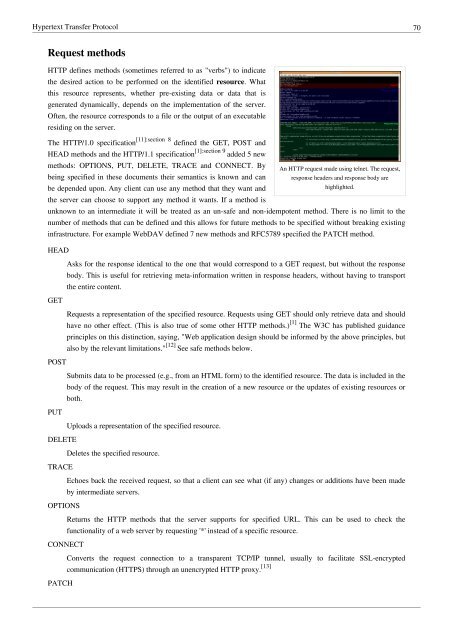Internet Protocol - Research by Kirils Solovjovs
Internet Protocol - Research by Kirils Solovjovs
Internet Protocol - Research by Kirils Solovjovs
Create successful ePaper yourself
Turn your PDF publications into a flip-book with our unique Google optimized e-Paper software.
Hypertext Transfer <strong>Protocol</strong> 70<br />
Request methods<br />
HTTP defines methods (sometimes referred to as "verbs") to indicate<br />
the desired action to be performed on the identified resource. What<br />
this resource represents, whether pre-existing data or data that is<br />
generated dynamically, depends on the implementation of the server.<br />
Often, the resource corresponds to a file or the output of an executable<br />
residing on the server.<br />
The HTTP/1.0 specification [11]:section 8 defined the GET, POST and<br />
HEAD methods and the HTTP/1.1 specification [1]:section 9 added 5 new<br />
methods: OPTIONS, PUT, DELETE, TRACE and CONNECT. By<br />
being specified in these documents their semantics is known and can<br />
be depended upon. Any client can use any method that they want and<br />
the server can choose to support any method it wants. If a method is<br />
An HTTP request made using telnet. The request,<br />
response headers and response body are<br />
highlighted.<br />
unknown to an intermediate it will be treated as an un-safe and non-idempotent method. There is no limit to the<br />
number of methods that can be defined and this allows for future methods to be specified without breaking existing<br />
infrastructure. For example WebDAV defined 7 new methods and RFC5789 specified the PATCH method.<br />
HEAD<br />
GET<br />
POST<br />
PUT<br />
Asks for the response identical to the one that would correspond to a GET request, but without the response<br />
body. This is useful for retrieving meta-information written in response headers, without having to transport<br />
the entire content.<br />
Requests a representation of the specified resource. Requests using GET should only retrieve data and should<br />
have no other effect. (This is also true of some other HTTP methods.) [1] The W3C has published guidance<br />
principles on this distinction, saying, "Web application design should be informed <strong>by</strong> the above principles, but<br />
also <strong>by</strong> the relevant limitations." [12] See safe methods below.<br />
Submits data to be processed (e.g., from an HTML form) to the identified resource. The data is included in the<br />
body of the request. This may result in the creation of a new resource or the updates of existing resources or<br />
both.<br />
DELETE<br />
TRACE<br />
OPTIONS<br />
CONNECT<br />
PATCH<br />
Uploads a representation of the specified resource.<br />
Deletes the specified resource.<br />
Echoes back the received request, so that a client can see what (if any) changes or additions have been made<br />
<strong>by</strong> intermediate servers.<br />
Returns the HTTP methods that the server supports for specified URL. This can be used to check the<br />
functionality of a web server <strong>by</strong> requesting '*' instead of a specific resource.<br />
Converts the request connection to a transparent TCP/IP tunnel, usually to facilitate SSL-encrypted<br />
communication (HTTPS) through an unencrypted HTTP proxy. [13]


